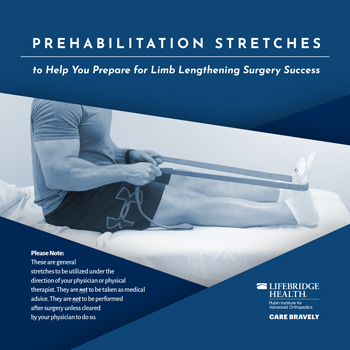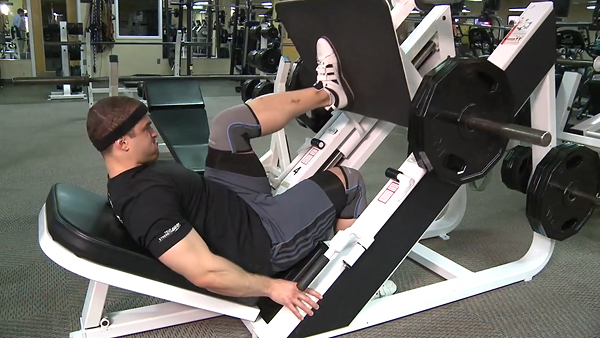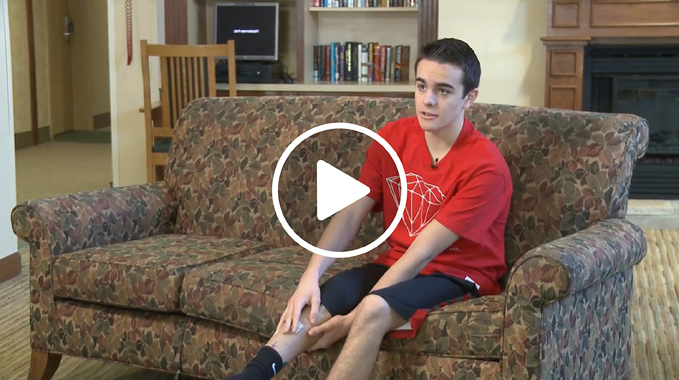Limb Length Discrepancy (LLD)
What is limb length discrepancy?
A Limb Length Discrepancy (LLD) occurs when one limb is a different length than its opposing limb. The causes of limb length discrepancies are divided into three major groups:
- congenital (from birth) limb length discrepancies,
- developmental (from a childhood disease or injury that slows or damages the growth plates) limb length discrepancies, and
- posttraumatic (from a fracture that leads to shortening of the bone ends) limb length discrepancies.
Differences in arm length do not usually cause changes in how the arms function, except in severe cases, so this web page will focus on the treatment of differences in leg length.
How can a limb length discrepancy be corrected?
There are three ways to equalize a limb length discrepancy:
- use a shoe lift
- shorten the long leg
- lengthen the short leg
Most patients do not like wearing a lift greater than 2 cm (3/4 in). For discrepancies greater than 2 cm (3/4 in), but less than 5 cm (2 in), shortening of the long leg can be considered.
How are limbs shortened?
For growing children, shortening of the long limb can be accomplished with a simple, minimally invasive procedure called epiphysiodesis. This stunts the growth and is highly effective. Timing is key. Starting too early will cause too much shortening, and starting too late will undercorrect the limb length discrepancy. The doctors at the International Center for Limb Lengthening at the Rubin Institute for Advanced Orthopedics use the Multiplier app, developed here, to help predict the ideal timing for this surgery.
In adults, the growth plates are already closed, so epiphysiodesis is not an option. To shorten the lower limb in an adult, a segment of bone has to be surgically removed. This is typically done in the femur (thigh bone), and the bone is fixed with an intramedullary nail. The biggest advantage of this method is that it immediately equalizes the limb length discrepancy in cases in which the discrepancy is less than 5 cm (2 in).
One downside of both epiphysiodesis and surgical shortening is that the patient’s height is reduced by the amount of shortening. We generally do not recommend shortening by more than 5 cm (2 in), so the height loss is never greater than 5 cm (2 in).
 To help you prepare for limb lengthening surgery success, we have developed this brochure of prehabilitation stretches to perform in the months prior to surgery. This is not medical advice; please consult with your doctor before beginning any exercise regime.
To help you prepare for limb lengthening surgery success, we have developed this brochure of prehabilitation stretches to perform in the months prior to surgery. This is not medical advice; please consult with your doctor before beginning any exercise regime.When is limb lengthening considered?
For patients who do not want to undergo shortening or epiphysiodesis for discrepancies less than 5 cm (2 in), and in cases in which the discrepancy is greater than 5 cm (2 in), limb lengthening is the procedure of choice to achieve equal leg lengths. Limb lengthening is a more complex and challenging procedure to undergo, compared to shortening. Epiphysiodesis and shortening can be combined with lengthening to decrease the amount of lengthening required. Patients must keep in mind that epiphysiodesis is a much simpler procedure than lengthening. Limbs are lengthened by either external fixators or internal lengthening rods.
What is a congenital limb length discrepancy?
“Congenital” means “born with it”, as opposed to something that occurs late in life as a result of an accident, for example. Cases of congenital limb length discrepancy often present the most challenging and difficult lengthenings to perform and should be treated only by experts who have significant experience with lengthening of developmental and posttraumatic limb length discrepancy. Not only is the amount of limb length discrepancy in congenital cases frequently large, it progressively and proportionally increases with time as the patient grows.
Currently, there is no known way to reliably accelerate the growth rate of the short leg. In addition to problems concerning the bone, the soft tissues in congenital cases are unusually thickened and contracted, which makes them resist the stretching required by the lengthening process. The hip, knee, and/or ankle may also be underdeveloped, malaligned, and/or unstable. All of these factors must be considered and addressed to avoid irreversible damage to joints, nerves and muscles.
The International Center for Limb Lengthening’s experts have extensive experience in reconstruction and lengthening of the congenitally short femur and tibia. Congenital shortening of the femur is referred to as proximal femoral focal deficiency (PFFD) or congenital femoral deficiency (CFD). Congenital shortening of the tibia is often associated with partial or complete absence of the smaller adjacent fibula bone; this is called fibular hemimelia. Tibial hemimelia is a congenital shortening of the leg segment where all or part of the tibia is missing. Posteromedial bowing of the tibia is another type of congenital shortening of the tibia associated with characteristic tibial and foot problems. Each of these types of congenital shortening requires a different approach to lengthening reconstruction surgery, and each surgery must be adjusted to fit the needs and situation of the individual patient.
At the International Center for Limb Lengthening, we have successfully treated all of the above-mentioned types of congenital limb length discrepancy. Many of the techniques employed were developed by our team.
How is a life treatment plan created for a child with a congenital limb length discrepancy?
Creating a child’s life treatment plan starts by accurately predicting the amount of limb length discrepancy that will be present when the child reaches the end of growth (skeletal maturity) using our Multiplier app. We identify all the deformities and joint instabilities present and then develop a personalized treatment strategy for reconstructing the limb, which may include reconstruction of the hip, knee, and/or ankle and foot as the first step. Lengthening reconstruction surgery may involve one or more operations. Most cases of congenital limb length discrepancy can be treated with lengthening and reconstruction. In many cases, we prefer to start the lengthening and reconstruction surgery process before the patient reaches the age of 4 years, often as young as 2 years of age.
What are alternatives to limb lengthening?
For severe degrees of limb length discrepancy, or in situations where the patient/family is unwilling or unable to undergo the rigors of limb lengthening, other options exist. An amputation can be performed, which allows the residual limb to fit into a prosthesis. The prosthesis can be lengthened to equalize the limb length discrepancy as the child grows. We call this prosthetic reconstruction surgery, and it includes operations such as Symes removal of the foot, removal of the leg below the knee or through the knee. For very severe cases, rotationplasty is an option. Although this may be the best treatment option in the most severely deficient cases in which one or more joints are missing, in our opinion, it is not the best option for the majority of patients.
Our lengthening reconstruction surgery for both the femur and the tibia, and even for very large limb length discrepancies, has excellent results. Joint function is often not only preserved but also improved. Our doctors will have a very frank and open discussion with you regarding all the treatment options available to you. In some extreme cases, we may advise against limb lengthening if we feel that the end result would be inferior to that which can be achieved by amputation reconstruction surgery.
What is a developmental limb length discrepancy?
Developmental limb length discrepancy conditions are not present at birth but develop during childhood. Developmental limb length discrepancies include those caused by conditions such as growth plate injury and growth arrest, Ollier disease, multiple hereditary exostoses, polio, infection, radiation, cerebral palsy and spina bifida. Most cases can be treated by one or two lengthenings. This limb length discrepancy group often has associated deformities. If present, these can also be corrected at the same time as the lengthening.
What is a posttraumatic limb length discrepancy?
Posttraumatic limb length discrepancy occurs after a broken bone heals in a shortened position, called a malunion. Along with shortening, there can also be angular problems (crooked bones). Most of these cases occur in adults, and most can be corrected with only one lengthening, and the associated deformity can be treated at the same time. Many of these situations can be treated by the internal lengthening nail method, though for many cases, the external fixator method is preferred. Our doctors will review all of the options with you and inform you about the pros and cons of each option.
Why choose the International Center for Limb Lengthening for limb length discrepancy treatment?
Treating limb length discrepancies is a complex process. Your doctor at the International Center for Limb Lengthening will take the time to make sure you understand all of your options and then will customize your treatment to meet your specific needs. Our patients benefit from our team-centered approach with world-renowned surgeons and specialized physician assistants, nurses and physical therapists. Our physical therapists are among the most experienced in the world in managing the lengthening process. We help patients with limb length discrepancies achieve their best possible result.
Video: Limb Length Discrepancy: Cole’s Story
Chat with a doctor about limb length discrepancies
Our doctors hold free monthly chats on various subjects, including limb length discrepancies. Click here for more information about our monthly chats.
Doctors who treat limb length discrepancies
*Patients Over 16 Years Old Only








